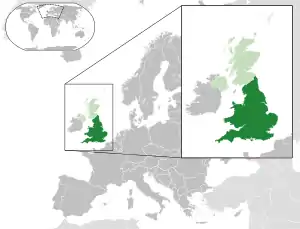Sentencing Council
The Sentencing Council for England and Wales is a non-departmental public body that is responsible for developing sentencing guidelines, monitoring the use of guidelines and assessing and reviewing a wide range of decisions relating to sentencing. It was established in April 2010 in consequence of the Coroners and Justice Act 2009, replacing the Sentencing Guidelines Council and the Sentencing Advisory Panel, its predecessor bodies.
_logo.png.webp) | |
| Agency overview | |
|---|---|
| Formed | April 2010 |
| Preceding agencies |
|
| Type | Advisory non-departmental public body |
| Jurisdiction | England and Wales |
| Headquarters | The Royal Courts of Justice, London, WC2A 2LL |
| Agency executives |
|
| Parent department | Ministry of Justice |
| Key document | |
| Website | www |
| Map | |
 England and Wales in the UK and Europe | |
The Council aims to ensure a consistent approach to sentencing, demystify court processes and sentencing for victims and the public, and increase confidence in the criminal justice system.
The Act gives the Sentencing Council a statutory duty to prepare sentencing guidelines about the discharge of a court's duty under section 144 of the Criminal Justice Act 2003 (c. 44) (reduction in sentences for guilty pleas), and sentencing guidelines about the application of any rule of law as to the totality of sentences. It is able to prepare sentencing guidelines about any other matter.
It is also required to consider the impact of sentencing practice and the Government may ask it to look at the impact of policy and legislative proposals relating to sentencing.
The Council comprises eight members of the judiciary and six non-judicial members, all with expertise in the criminal justice system. The Council’s chairman is Lord Justice William Davis, a Court of Appeal judge.
All members of the Council were appointed by the Lord Chancellor and the Lord Chief Justice.
History
The Sentencing Guidelines Council was a non-departmental public body of the United Kingdom government, created by s.167 of the Criminal Justice Act 2003. It gave authoritative guidance on sentencing to the courts of England and Wales. The Council was chaired by the Lord Chief Justice of England and Wales and comprised seven judicial members, appointed by the Lord Chancellor after consultation with the Lord Chief Justice and the Home Secretary, and four non-judicial members, appointed by the Home Secretary after consultation with the Lord Chancellor and Lord Chief Justice.
The seven judicial members had to include a circuit judge, a district judge (magistrates courts) and a lay magistrate. The non-judicial members had to be experienced in policing, criminal prosecution, criminal defence or victim welfare. In April 2010 it became the Sentencing Council (combining also the functions of the Sentencing Advisory Panel).[1][2]
References
- "History - Sentencing Council". Retrieved 14 August 2011.
- "The changing structures for sentencing guidelines". Parliament. Retrieved 14 August 2011.
_(2022).svg.png.webp)